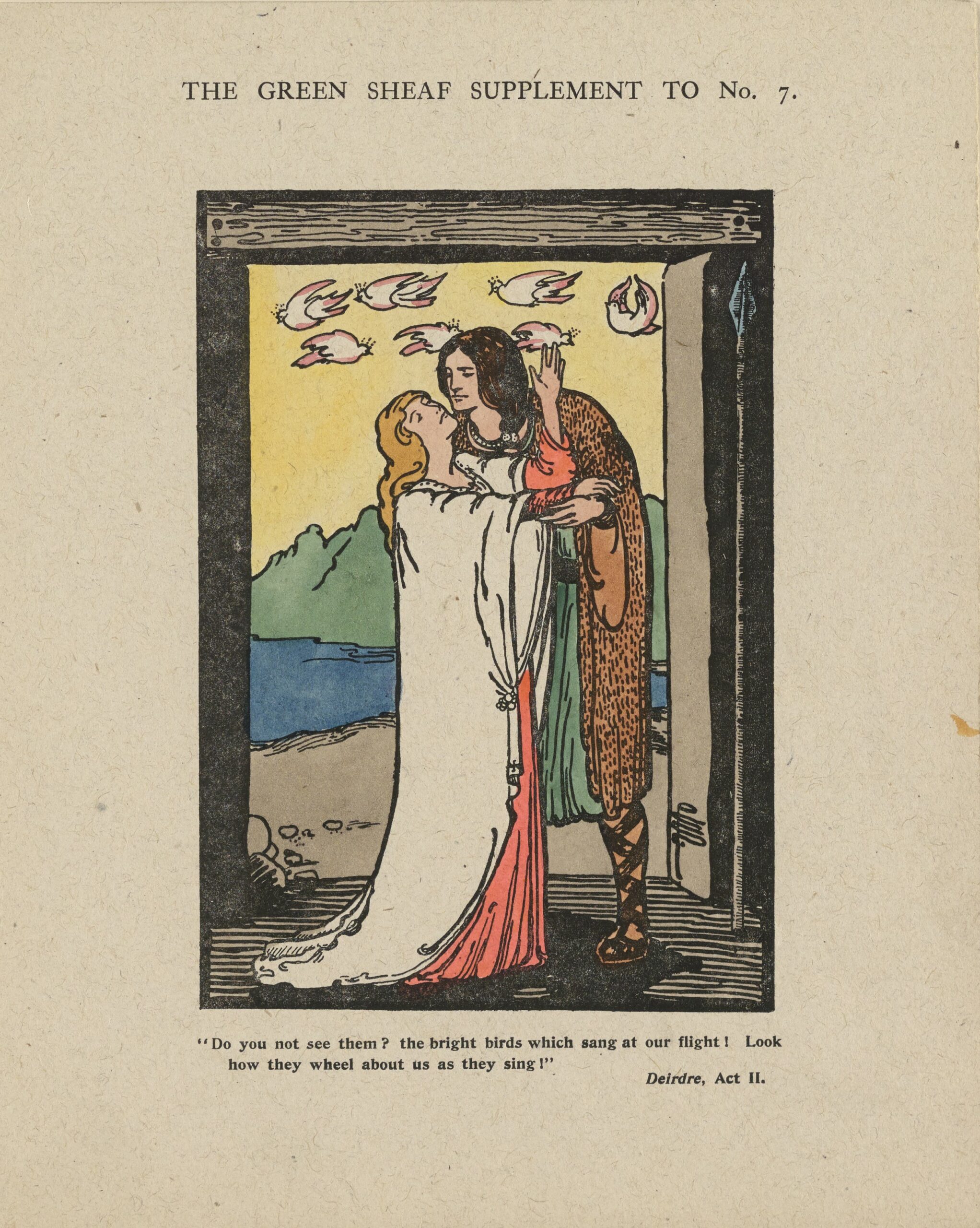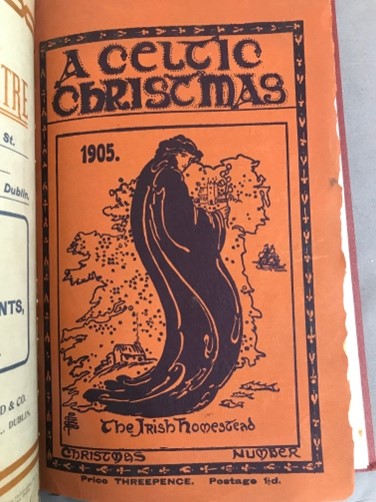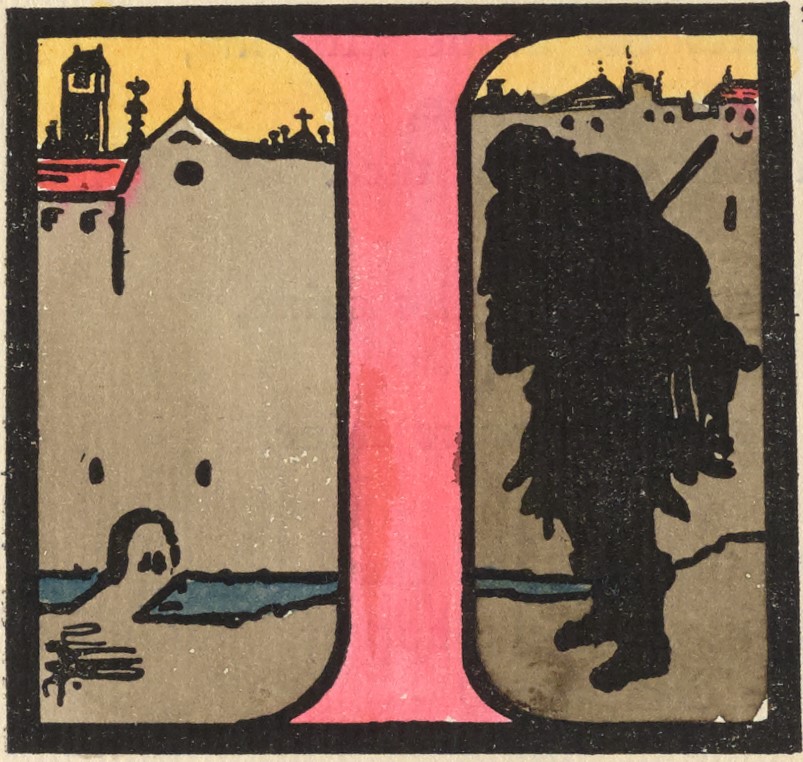Critical Introduction to The Green Sheaf
No. 7, 1903

With its seventh number in November 1903 The Green Sheaf began the second half of its thirteen-issue print run. This monthly number stands out for both its unique material format and its new transatlantic distribution system. In terms of format, a paratextual supplement all but overwhelms the host issue, which is brief in extent and limited in content. After the Green Sheaf’s inaugural number, each succeeding issue had been sixteen pages in length. Number 7 reverted to the eight-page extent of the first issue, but dramatically expanded this limit by including, as a twelve-page Supplement, an entire three-act play, printed in double columns by Farncombe & Sons, with hand-coloured illustrations by Pamela Colman Smith (1878-1951) and Cecil French (1879-1953). John Baillie (1868-1926), whose Art Gallery in Bayswater regularly advertised in The Green Sheaf, opened a well-received exhibition of mystical water-colour drawings by these two artists on 13 November (“Fine-Art Gossip” 658; “The Galleries and Ateliers” 6). The combined demands of producing the large Supplement while preparing for the exhibition that month may have limited the time Smith had for the issue itself; its contents include a mere five poems, two black-and-white line drawings, and two hand-coloured ornaments. With the exception of the December issue, which was once again sixteen pages in length, The Green Sheaf’s remaining monthly numbers kept to the eight-page limit, sometimes expanded by supplements. The second significant change introduced in the seventh number was Smith’s announcement that the magazine could now be purchased at Brentano’s Literary Emporium, New York’s largest bookstore. Appearing on both the front cover and the Supplement’s advertisements, the announcement signalled the editor’s desire to increase her magazine’s economic viability by targeting American consumers (Smith, Illustrated Advertisement for Bookplates). In a further appeal to this transatlantic readership, Smith makes back numbers available for the first time, priced at eighteenpence each (Smith, Front Cover).

Both the issue’s poems and the Supplement’s play explore themes of love and death. Smith’s colour palette of green, slate, and brown shades, contrasted by mustard, coral, and deep purple, expresses the romance and passion of these concerns, particularly in the illustrations she and French produced for Deirdre: A Drama in Three Acts (figs. 1 and 2). A traditional Irish legend about the doomed lovers Deirdre and Naisi [sic] and their violent deaths at the hands of traitorous King Conor, Deirdre was retold by many key members of the Irish Revival movement, including Green Sheaf contributors Lady Augusta Gregory (1852-1932), J. M. Synge (1871-1909) and W.B. Yeats (1865-1939) (Smyth 174 and 164). The Supplement to The Green Sheaf offers a version by A.E. (George Russell, 1867-1935), who had called for modern poets to recreate traditional bardic tales in an essay entitled “The Dramatic Treatment of Heroic Literature” (Boyd 257). According to Ernest Boyd, A.E.’s Deirdre was “the first important play to be performed by the company from which sprang the Irish National Theatre” (ibid.). The Irish National Dramatic Society formed in 1902, having evolved from the Irish Literary Theatre founded by Gregory and Yeats in 1899 (Welch 20, 22). Notably, the Irish National Theatre Society, which produced a revival of Deirdre in February 1904, asserts its Dramatic Rights to the play on the Supplement’s title page; disputes over transatlantic rights led A.E. to resign from the Society a few months later (Welch 29, 31). In addition to the Deirdre Supplement for The Green Sheaf, Pamela Colman Smith collaborated with A.E. on another important periodical of the national revival: the Irish Homestead, which the latter edited. Smith’s cover design graced this magazine’s special number, A Celtic Christmas, from 1904 to 1908. In keeping with the mythic woman-nation image prevalent in the Irish Revival movement (Doyle 35), Smith’s illustration represents Deirdre as the national spirit by superimposing the monumental figure of a robed woman onto the map of Ireland (fig. 3).

While the presence of A.E.’s Deirdre as a Green Sheaf supplement attests to the magazine’s connection to the Irish Revival, only one of the issue’s five poems could be associated with the movement: “The Calling Voice,” by Alix Egerton (1870-1923). The poem’s references to supernatural encounters with “The Land of Faery” recall Egerton’s “Faerie Dance” in The Green Sheaf’s fifth number, and may also allude to a vision of The Sidhe that she and Smith claimed to have experienced on a visit to Peacock’s Well (Campbell 262). Egerton’s poem appears on the recto of the first opening, sharing the page with Smith’s brief quatrain personifying “Echo” as an elusive female spirit; a pair of ornamental roses separates the two lyrics (Database of Ornament). On the verso is the issue’s opening poem, “Autumn,” by fourteen-year-old Eleanor Vicocq Ward (1889-1976), limned with a full-page decorative border by her older sister, Dorothy Priestley Ward (1879-1969). “Autumn” seems an apt choice for the November number’s leading item as its seasonal tropes chime with the issue’s themes of death and dying. However, the linear black-and-white design surrounding the poem lacks the vibrant colours of The Green Sheaf’s typical opening page. The same is true for the issue’s final full-page image, “The Old Book,” by American artist Frederick J. Waugh (1861-1940), which is likewise printed in black and white and left untinted. Smith’s coral-coloured ornamental roses separating her poem from Egerton’s and her pictorial initial “I” for “Blind Man’s Vigil” by John Masefield (1878-1967) (fig. 4) are the issue’s only hand-coloured images.

“Blind Man’s Vigil” is Masefield’s third and last contribution to The Green Sheaf. A celebrated poet and storyteller known for his nautical themes, Masefield fulfilled the magazine’s promise to give its readers “tales of pirates and the sea” (Smith, Front Cover). While the ballad may connect to the issue’s death themes, however, it gives love a wide berth. The eponymous narrator recounts burying casks of treasure on “the sunny beach of Muertos” (i.e., beach of Death) on the Spanish Main, and the subsequent capture and hanging of the rest of the crew. The speaker is the only surviving member of the pirate ship captained by the notorious “L’Ollanay” (François l’Olonais, 1630-1670), known as “Flail of the Spanish” (Masefield, 3-4; Cartwright, np). Masefield’s speaker uses racialized terminology for a geographic landform resembling a dark-coloured human head; “Blind Man’s Vigil” thus comes with an editorial warning of offensive language.
The last poem in the issue, “Eocene” by George Cecil Ives (1867-1950), is a homoerotic lyric celebrating a new day. Waking in bed, the speaker is greeted by “young Dawn,” who is “gorgeous and strong in gallant hardihood,” and who invites him outside to where “The River casts her bridal robe away” (6). “Eocene” means dawn in Greek and is also the geological term for the era of modern life on the planet. The Greek allusion illuminates Ives’s lyrical representation of a new day for men who love men. An early campaigner for homosexual law reform in Britain, Ives founded the Order of the Chæronea in 1897 as a support group for gays and was a member of the British Society for the Study of Sex Psychology (Cook 1). It is uncertain how Smith knew Ives, though she may have connected with him through Laurence Housman (1865-1959), a member of her circle who belonged to the Order. Her willingness to publish Ives’s frankly homoerotic poem in her little magazine is characteristic of Smith’s open approach to non-traditional expressions of gender and sexuality throughout her career. In the next number of The Green Sheaf, Smith would publish her own lyrical “Dawn,” in which a woman invites the speaker to join her by the sea at “the glint of day” (Smith 11). Smith’s “Dawn” may be her poetic response to Ives’s “Eocene” from a queer woman perspective.
Smith used the back pages of the issue and its Supplement to advertise her artistic work to Green Sheaf subscribers. An illustrated ad in the Supplement demonstrates her graphic skills and promotes her availability for custom bookplates, Christmas cards, dance cards, and dinner menus “Designed, Hand-printed, and Hand-coloured to Order” at her Chelsea studio (Smith, Illustrated Advertisement). For eighteenpence, readers were told, they might also purchase a “Just Published” hand-coloured print by Smith illustrating Yeats’s play Cathleen Ni Hoolihan, available from either “The Editor of The Green Sheaf” in Chelsea or Elkin Mathews on Vigo Street (ibid.). The issue’s back page advertises Smith’s “for hire” performances of West Indian tales in her storytelling role of Gelukiezanger as well as an assortment of her hand-coloured prints of actress Ellen Terry (1847-1928) in various roles (Advertisements 8). Other advertisements promoted work by members of Smith’s professional circle. In addition to advertising John Baillie’s Gallery, where her own art was currently being exhibited, Smith printed Elkin Mathews’s publishing list for Autumn 1903 (Advertisements 8). The latter included works by two of the present issue’s contributors: Alix Egerton’s The Lady of the Scarlet Shoes and John Masefield’s Ballads. Smith uses the front cover to advertise The Green Sheaf’s next two issues. The December number (No. 8) was to include work by regular contributors Alix Egerton, Cecil French, and Christopher St. John (1871-1960), as well as newcomers Francis Annesley (1884-1914), Victor Bridges (1878-1972), Reginald Rigby (1881-1943), and E. Harcourt Williams (1880-1957), while the January issue was to feature “A Dream” by John Todhunter (1839-1916) as a supplement (Smith, Front Cover). With new contributors coming on board and work in hand for future issues, The Green Sheaf appeared to be thriving as the end of 1903 neared.
©2022 Lorraine Janzen Kooistra, FRSC, Senior Research Fellow, Toronto Metropolitan University Centre for Digital Humanities
Works Cited
- Advertisements. The Green Sheaf, No. 7, 1903,
p. 8. Green Sheaf Digital Edition, edited by
Lorraine Janzen Kooistra, Yellow Nineties 2.0,
Toronto Metropolitan University Centre for Digital Humanities, 2022.
https://1890s.ca/GSV7-supplement-ads/
- A.E. [George Russell]. Deirdre: A Drama in Three
Acts, illustrated by Cecil French and Pamela Colman Smith. Supplement (pp. 1-12) to The
Green Sheaf, No. 7, 1903. Green Sheaf Digital
Edition, edited by Lorraine Janzen Kooistra, Yellow Nineties 2.0, Toronto Metropolitan University Centre for
Digital Humanities, 2022.
https://1890s.ca/GSV7-supplement1/
- Boyd, Ernest A. “ ‘A.E.’—Mystic and Economist.” North American Review, vol. 202, no. 717, 1 July 1915, pp. 251-61.
- Campbell, Lady Archibald. “Faerie Ireland.” Occult Review, November 1907, pp. 259-74.
- Cartwright, Mark. “François L’Olonais.” World History Encyclopedia. World History Encyclopedia, 21 Oct 2021. Web. 20 Jan 2022.
- Cook, Matt. “Families of Choice? George Ives, Queer Lives and the Family in Early Twentieth-Century Britain.” Gender & History, vol. 22, no. 1, 2010, pp. 1-20.
- Doyle, Maria-Elena. “A Spindle for the Battle: Feminism, Myth, and the Woman-Nation in Irish Revival Drama.” Theatre Journal, vol. 51, no. 1, 1999, pp. 33-46.
- Egerton, Alix. “The Calling Voice.” The Green
Sheaf, No. 7, 1903, p. 2. >Green Sheaf
Digital Edition, edited by Lorraine Janzen Kooistra, Yellow Nineties 2.0, Toronto Metropolitan
University Centre for Digital Humanities, 2022.
https://1890s.ca/GSV7-egerton-calling/
- —. “The Fairy Dance,” decorated by Pamela Colman Smith. The Green Sheaf, No. 5, 1903, p. 6. Green Sheaf Digital Edition, edited by Lorraine
Janzen Kooistra, Yellow Nineties 2.0, Toronto
Metropolitan University Centre for Digital Humanities, 2022.
https://1890s.ca/GSV5-egerton-fairy/
- French, Cecil. “Then in my dream I came nigh him.” Illustration for Deirdre, by A.E. Supplement (np) to The Green Sheaf,
No. 7, 1903. Green Sheaf Digital Edition, edited
by Lorraine Janzen Kooistra, Yellow Nineties 2.0,
Toronto Metropolitan University Centre for Digital Humanities, 2022.
https://1890s.ca/GSV7-supplement2/
- “Fine-Art Gossip.” The Athenaeum, November 14, 1903, p. 658.
- “The Galleries and Ateliers.” The Daily Mirror, November 18, 1903, p. 6.
- Ives, George. “Eocene,” The Green Sheaf, No.
7, 1903, p. 7 Green Sheaf Digital Edition, edited
by Lorraine Janzen Kooistra, Yellow Nineties 2.0,
Toronto Metropolitan University Centre for Digital Humanities, 2022.
https://1890s.ca/GSV7-ives-eocene/
- Masefield, John. “Blind Man’s Vigil,” pictorial initial by Pamela Colman
Smith. The Green Sheaf, No. 7, 1903, pp. 4-5.
Green Sheaf Digital Edition, edited by
Lorraine Janzen Kooistra, Yellow Nineties 2.0,
Toronto Metropolitan University Centre for Digital Humanities, 2022.
https://1890s.ca/GSV7-masefield-blind/
- Smith, Pamela Colman. “Dawn.” The Green Sheaf,
No. 8, 1903, p. 11. Green Sheaf Digital Edition,
edited by Lorraine Janzen Kooistra, Yellow Nineties
2.0, Toronto Metropolitan University Centre for Digital
Humanities, 2022.
https://1890s.ca/GSV8-smith-dawn/
- —. “Do you not see them?” Illustration for Deirdre, by A.E. Supplement (np) to
The Green Sheaf, No. 7, 1903. Green Sheaf Digital Edition, edited by Lorraine
Janzen Kooistra, Yellow Nineties 2.0, Toronto
Metropolitan University Centre for Digital Humanities, 2022.
https://1890s.ca/GSV7-supplement3/
- —. “Echo,” decorated by Pamela Colman Smith. The
Green Sheaf, No. 7, 1903, p 3. Green Sheaf
Digital Edition, edited by Lorraine Janzen Kooistra, Yellow Nineties 2.0, Toronto Metropolitan
University Centre for Digital Humanities, 2022.
https://1890s.ca/GSV7-smith-echo/
- —. Front Cover. The Green Sheaf, No. 7,
1903, p. [i]. Green Sheaf Digital Edition, edited
by Lorraine Janzen Kooistra, Yellow Nineties 2.0,
Toronto Metropolitan University Centre for Digital Humanities, 2022.
https://1890s.ca/GSV7-smith-front-cover/
- —. Illustrated Advertisement for Bookplates and Private Christmas
Cards, Supplement (p. 12) to The Green Sheaf, no. 7, 1903. Green Sheaf
Digital Edition, edited by Lorraine Janzen Kooistra, Yellow Nineties 2.0, Toronto Metropolitan
University Centre for Digital Humanities, 2022
https://1890s.ca/GSV7-supplement-ads/
- Smyth, Gerry. “Two Dramatic Treatments of the ‘Déirdre’ legend: A Case Study in Irish Betrayal.” Irish Studies Review, vol. 21, no. 2, 2013, pp. 164-177.
- Supplement Advertisements, p. 12. The Green Sheaf, No. 7, 1903. Green Sheaf Digital Edition, edited by Lorraine Janzen Kooistra,
Yellow Nineties 2.0, Toronto Metropolitan
University Centre for Digital Humanities, 2022.
https://1890s.ca/GSV7-supplement-ads/
- Ward, Eleanor Vicocq. “Autumn,” decorative border by Dorothy P. Ward.
The Green Sheaf, No. 7, 1903, p. 2 Green Sheaf Digital Edition, edited by Lorraine
Janzen Kooistra, Yellow Nineties 2.0, Toronto
Metropolitan University Centre for Digital Humanities, 2022.
https://1890s.ca/GSV7-ward-autumn/
- Waugh, Frederick J. “The Old Book.” The Green
Sheaf, No. 7, 1903, p. 7. Green Sheaf Digital
Edition, edited by Lorraine Janzen Kooistra, Yellow Nineties 2.0, Toronto Metropolitan University Centre for
Digital Humanities, 2022.
https://1890s.ca/GSV7-waugh-book/
MLA citation:
Kooistra, Lorraine Janzen. “Critical Introduction to The Green Sheaf No. 7, 1903.” Green Sheaf Digital Edition, Yellow Nineties 2.0, edited by Lorraine Janzen Kooistra, Toronto Metropolitan University Centre for Digital Humanities, 2023. https://1890s.ca/GS7_introduction/.